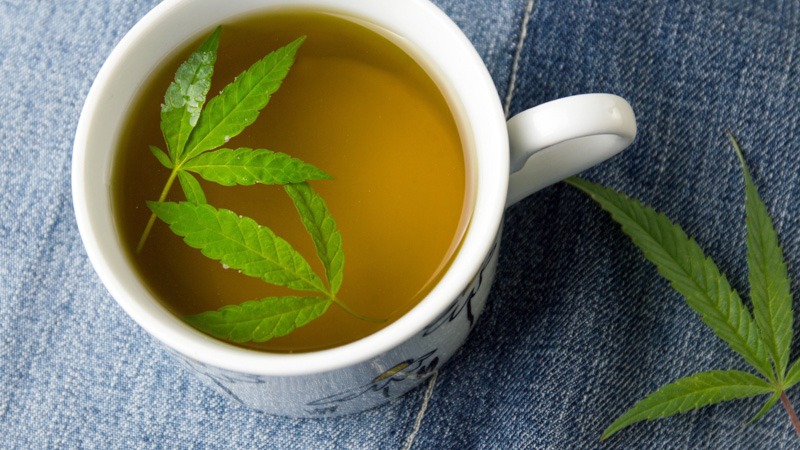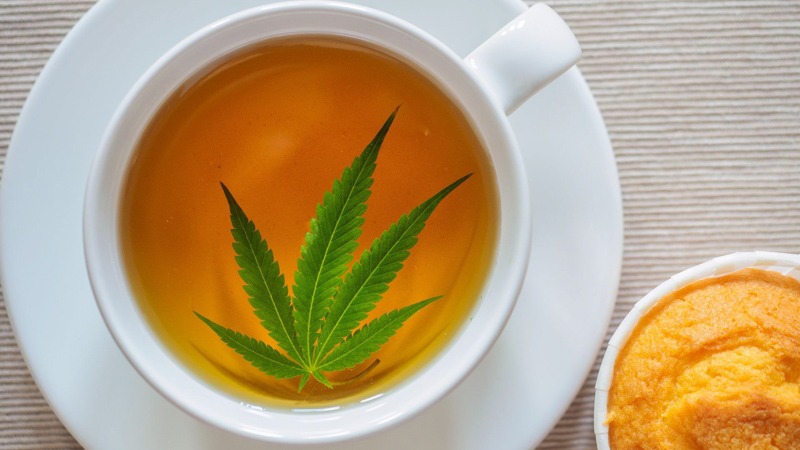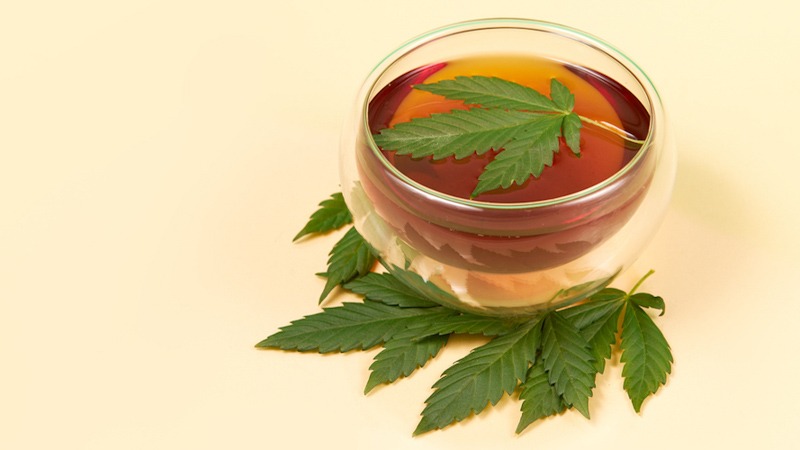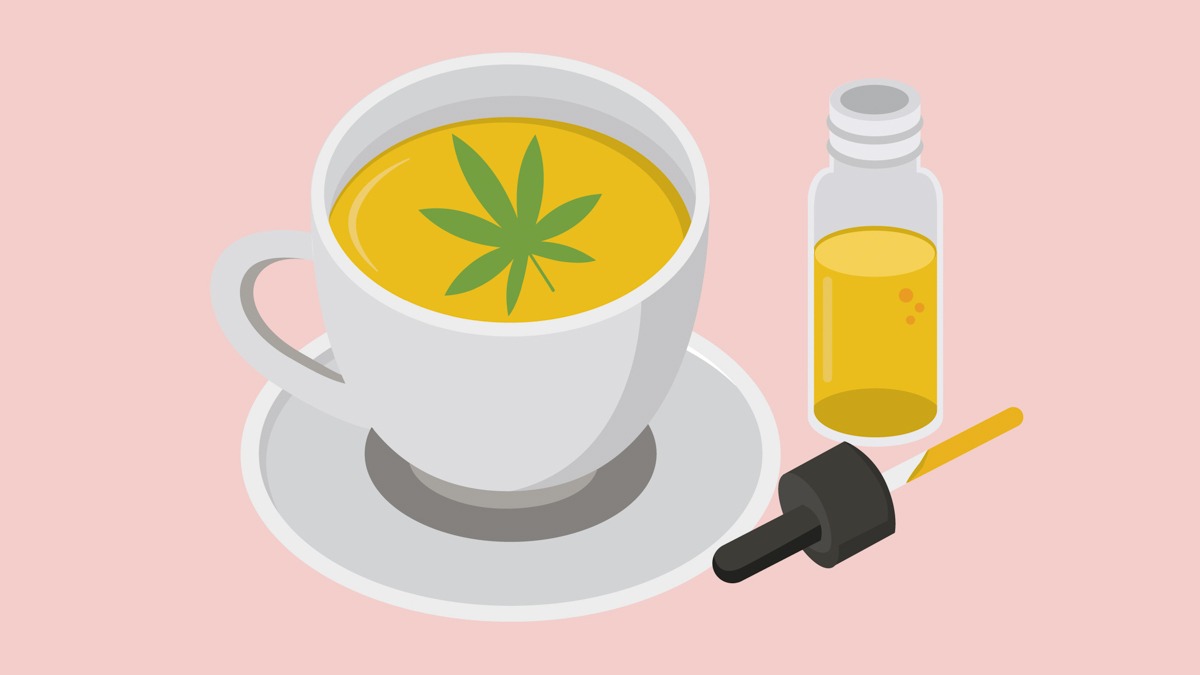Tea is a great way to consume CBD. Drinking CBD tea is a relaxing and therapeutic way to use the cannabinoid.
Whether you’re looking to ease an upset stomach, control anxiety symptoms, or treat chronic pain, CBD tea is a gentle way to improve your overall health.
If you’re a fan of brewing up a midday cup of tea to enjoy at lunch, a relaxing cup before bed, or enjoy waking up to a hot brew in the morning, adding CBD to your drink can be an easy way to incorporate it into your diet.
What is CBD Tea?
Tea is a hot drink traditionally made by infusing the dried leaves of the tea plant (camellia Sinensis) with boiled water.
Tea comes in many forms, with the main three being white, black, and green teas. Certain teas may boost your immune system, fight inflammation, and protect your body from the harmful effects of free radicals.
CBD is a cannabinoid found naturally in cannabis and hemp. The plant as a whole has been used as a medicine for thousands of years.
In modern times, we’ve discovered the medical benefits of CBD and the other cannabinoids present in hemp and cannabis. We have now learned how to isolate and extract them to create concentrated extracts.
CBD comes in many forms. You’ll find CBD as oil, edibles, capsules, topicals, and vape liquids.
CBD also comes in extracts that contain only CBD (isolate CBD), CBD with all other natural cannabinoids present in hemp (full-spectrum), and CBD with all other naturally present cannabinoids with THC removed (broad-spectrum).
CBD tea combines tea and CBD to create a hot drink that boasts the benefits of tea and CBD.
It can be made and consumed in various ways, but the basic ingredients involve tea leaves and CBD of some form.
Black, white, and green teas can be used, and other herbal teas such as rooibos, chamomile, peppermint, and hibiscus.
CBD oils in isolate, broad-spectrum, full-spectrum, and whole hemp variants can be used to make CBD tea, depending on your personal preferences.
What are the Benefits of CBD Tea?
 There are several benefits of consuming both CBD and certain types of tea.
There are several benefits of consuming both CBD and certain types of tea.
Combining the two gives you the benefits of both tea and CBD in one tasty hot drink. So, how can CBD tea benefit you?
Looking at the benefits of certain teas and CBD oil will give you an idea of how CBD tea can benefit you.
1. The Benefits of CBD Oil
CBD has many health benefits. It can be used to treat various conditions, from severe health problems such as cancer to aiding muscle recovery after exercise.
Full-spectrum and broad-spectrum CBD oil is considered the most effective for treating the widest range of health issues. This is due to the entourage effect [1]. When CBD is consumed alongside a rich cannabinoid profile, it works far better.
The Beneficial Qualities of CBD
- Pain-relieving
- Anti-inflammatory
- Anti-anxiety
- Anti-seizure
- Neuroprotective
- Antibacterial
- Antioxidative
- Sleep-promoting
The Conditions CBD May Help
The list of conditions that CBD can help is almost endless. As CBD is further researched, more and more health benefits are added to the list.
Below is a list of conditions that CBD can help with. Although this list could be much longer, the effects of CBD on these conditions are backed by scientific studies and/or scientific research.
- Anxiety
- Depression
- Stress
- Attention deficit disorder (ADHD)
- Epilepsy
- Cancer
- Asthma
- Acne
- Psoriasis
- Eczema
- Dermatitis
- Arthritis
- Heart disease
- High blood pressure
- Diabetes
- Dementia
- Multiple sclerosis
- Chronic pain conditions
- Addiction
2. The Benefits of Tea (Camellia Sinensis)
Several studies have discovered that various teas can benefit both mental and physical health [2]. Different teas may help boost the immune system, encourage weight loss, lower cholesterol, and help fight against certain diseases.
Several experts suggest that tea is a much better alternative to drinking coffee. There are fewer side effects of drinking tea due to its lower caffeine content.
However, some types of tea are better than others when caffeine content and potential health benefits are concerned.
Let’s take a look at the differences between white, black, and green tea, the benefits of each, so you can assess which type is the best to use in your CBD tea.
Black Tea
Back tea is produced by drying and fermenting the leaves of the camellia Sinensis plant. It has the highest caffeine content of any tea — containing 47 mg of caffeine per cup.
It has a strong flavor and is commonly combined with milk and sugar. It’s considered the least beneficial of the teas, but it still has many health advantages:
- Has antioxidant properties
- May lower LDL cholesterol (bad cholesterol)
- May improve gut health
- May reduce blood pressure
- May lower blood sugar levels
White Tea
White tea is made from the new growth and young leaves of the camellia Sinensis plant. The leaves are steamed or pan heated to inactivate oxidation and then fully dried. White tea is considered the least processed variety of tea.
White tea has a delicate flavor and gets its color from the white hairs that form on young buds and leaves. White tea has the lowest caffeine content of all three tea types — containing 6 – 20 mg of caffeine per cup.
There are many health benefits associated with white tea that are similar to the benefits of green tea:
- Has antioxidative properties
- May reduce the risk of heart disease
- May help aid weight loss
- It helps protect the teeth from bacteria
- It May have anti-cancer properties
- Lowers the risk of insulin resistance
- Excellent for skin health
- Reduces blood pressure
- May protect against osteoporosis
- May help fight dementia
Green Tea
Green tea is made from the mature leaves of the camellia Sinensis plant. The leaves are steamed, pan-fried, or roasted. Green tea has a relatively low caffeine content at 28 mg per cup.
It’s high in flavonoids that may benefit heart health by lowering cholesterol, blood pressure and reducing clotting [3]. Green tea is renowned for its health benefits and is considered one of the best tea types to consume (along with white tea).
- Has antioxidative properties
- May reduce the risk of heart disease
- May improve brain function
- May help aid weight loss
- Reduces bad breath
- It May have anti-cancer properties
- May help diabetes
- Lowers the risk of insulin resistance
- Excellent for skin health
- Reduces blood pressure
- May protect against osteoporosis
- May help fight dementia
- May reduce inflammation
3. The Benefits of Herbal Teas
There are alternatives to traditional teas made from the camellia Sinensis plant. These teas also provide health benefits, and most of them contain no caffeine at all.
Below we have listed 4 of the best herbal teas to combine with CBD:
Rooibos Tea
- May aid heart health
- May prevent cancer
- Aids in the management of diabetes
- Aids healthy digestion
- Has anti-inflammatory properties
- Aids bone health
- May help with weight loss
- May lower blood pressure
- May help with allergies
- Promotes healthy skin
- Diuretic properties (may promote kidney health)
Chamomile Tea
- Reduces menstrual pain
- May lower blood pressure
- May regulate blood sugar levels
- Reduces inflammation
- It helps promote healthy sleep
- Eases cold and flu symptoms
- May promote digestive health
Peppermint Tea
- May ease stomach upsets
- May relieve headaches & migraines
- Relieves blocked sinuses & flu symptoms
- May boost energy levels
- May improve sleep & aid insomnia
- May fight bacterial infections
- Fights against bad breath
Hibiscus Tea
- It May help lower blood pressure
- May aid weight loss
- May promote healthy liver & kidney function
- It May have anti-cancer properties
- Has antibacterial qualities
How to Make CBD Tea?
 Now we’ve outlined the best types of tea to use for CBD tea and assessed the benefits of said teas as well as cannabidiol; it’s time to learn how to make it.
Now we’ve outlined the best types of tea to use for CBD tea and assessed the benefits of said teas as well as cannabidiol; it’s time to learn how to make it.
The method is relatively simple, but there are a few considerations to make to ensure you get the most out of your cup of CBD tea.
There are a few ways to make CBD.
The simplest way to make CBD tea is to grind up whole hemp flower and steep alone or with other herbs of your choice to enhance the flavor. Alternatively, you can combine CBD oil with your favorite tea beverage.
You can also purchase premixed CBD tea blends that cut out a few steps and make your life easier.
All methods are effective but getting a concentrated, and accurate dose is much easier when using CBD oil.
With both oil and flower methods, it’s crucial to use a binder.
CBD and other cannabinoids are not water-soluble, meaning you’ll need to use a binder to infuse it with the tea water. The binding agent helps the CBD infuse and ensures that it’s readily available for your body to absorb.
What You Will Need to Make CBD Tea
1. Select a Binding Agent
- Coconut oil
- Coconut milk
- Whole milk
- Butter
2. Select a Tea of Your Choice
- Green tea
- White tea
- Black tea
- Herbal tea
3. Select a CBD Product
- CBD hemp flower
- Full-spectrum CBD oil
- Broad-spectrum CBD oil
- Isolate CBD oil
How to Gauge Doses for CBD Tea
It’s difficult to gauge the right dose when using CBD. This is because the cannabinoid works differently for everyone.
The dose of CBD you need will depend on several different factors.
Your body weight, age, metabolism, and gender can affect the dose of CBD you’ll need. The condition you’re treating will also determine how much CBD you need.
This may require some self-experimentation to find the right dose of CBD for you and your condition. The best way to do this is to start with a low dose and increase it until you receive the effects you’re looking for.
This can be difficult if you’re using a premixed CBD tea or hemp flower to brew your tea.
If you’re already using CBD oil, edibles, or capsules to treat a condition, you’ll know how many milligrams you need in one dose. You can match the dose you’re already taking to the CBD tea.
If you’re not currently treating your condition with CBD, the easiest way to gauge a dose for CBD tea is to make the tea using CBD oil. This way, you can adjust your dose easily by adding more drops as needed.
Alternatively, if you’re using CBD flower, you can increase the amount of raw material you brew in your tea until you find your optimum dose.
If you prefer to use premixed CBD tea, you can start with a low-potency product and increase the potency if you don’t notice any change in your symptoms or don’t receive the effects you’re looking for.
How to Make the Perfect CBD Tea (Three Methods)
Method A: Using CBD Oil
Making CBD tea using CBD oil gives you ultimate flexibility in terms of dose.
Once you have chosen the type of tea, CBD oil, and binding agent, brewing the tea is relatively easy.
- First, you must bring a pot of water to the boil on the stove or in a kettle. Once the water has boiled, add one teaspoon of coconut oil or another binding agent of your choice to the water.
- Stir in the binding agent and use a thermometer to monitor the temperature of the water.
Once the temperature has dropped below 180 degrees Celsius (356 degrees Fahrenheit), it’s safe to start adding your CBD.
- When the temperature is below 180, add in the required dose of CBD oil. A good place to start is with 1 to 2 drops of low-potency CBD oil. Stir in the CBD oil to allow it to infuse fully.
- From here, the tea of your choice can be added and brewed for the required time.
- Once your tea has brewed, simply remove the tea bag or strain the tea leaves and enjoy.
Method B: Using Raw Hemp Flower
Using raw hemp flower (CBD bud) to make tea will produce a beverage with a full-bodied flavor and a rich cannabinoid profile.
There’s a bit more preparation involved if you want to make CBD tea this way, but the process is easy with the right equipment.
For this type of CBD tea, you will need a tea infuser. This a small cage you can place your bud in while it brews in the water.
- First, you must grind up the CBD bud into a fine powder to have more surface area to infuse into the water efficiently. Once ground, fill your tea infuser with the plant matter.
- Next, bring your water to a boil on the stove and drop the temperature down to a light simmer.
- You can now place the filled tea infuser into the simmering water. Leave the pan on low heat and simmer for 20 minutes.
This process converts the CBDA present in the bud into CBD — the more bioavailable compound.
- Once the solution is ready, remove the tea infuser and discard the contents.
- In a cup, add 1 teaspoon of coconut oil or another binding agent. Then, pour the CBD-infused water over the top and stir well.
- Once the solution is mixed, it can be consumed as it is, or another beneficial camellia tea or herbal tea can be added for extra flavor and further benefits.
Method C: Using Premixed CBD Tea
Using premixed CBD tea bags is the easiest way to make CBD tea.
CBD tea is available from several different companies and comes in a variety of strengths and tea types.
You’ll find CBD tea in strengths of 5 mg to 60 mg per tea bag in isolate, broad-spectrum, and full-spectrum variants.
CBD tea bags are often available with blends of green, white, and black tea and several different herbal blends such as chamomile and peppermint.
Unlike the other two methods, brewing doesn’t require the use of a binding agent. Most premixed CBD tea contains water-soluble CBD or has been mixed with a binder.
This means brewing your cup of tea is as easy as steeping the tea bag in a cup of hot water at 180 degrees Celsius for 3 to 10 minutes.
Does CBD Tea Get You High?
 THC is the psychoactive cannabinoid present in cannabis. CBD products contain minimal amounts of this cannabinoid, so consuming CBD tea will not get you high.
THC is the psychoactive cannabinoid present in cannabis. CBD products contain minimal amounts of this cannabinoid, so consuming CBD tea will not get you high.
Whether you are using CBD oil or hemp flowers, as long as it’s federally legal, it won’t contain any THC above 0.3%.
However, if you are using medical cannabis or extracts that contain significant amounts of THC (available at licensed dispensaries), you can expect an impairing effect.
Are There Any Side Effects of CBD Tea?
There are minimal side effects associated with CBD tea.
However, although you’re unlikely to experience any serious side effects from drinking CBD tea, some minimal side effects are associated with the cannabinoid.
There are also some possible side effects from the caffeine in tea. Again, these side effects are minimal but can be more prominent in certain people. If you’re particularly sensitive to caffeine, we recommend using a caffeine-free herbal tea alternatively.
Side Effects of CBD
- Dry mouth
- Appetite changes
- Drowsiness
- Fatigue
- Low blood pressure
- Diarrhea
Side Effects of Caffeine
- Restlessness
- Insomnia
- Dehydration
- Dependency
- Headaches
- Dizziness
Final Thoughts: Is CBD Tea Worth Your Time?
The benefits of CBD and certain teas can be combined to create a herbal drink that’s good for the mind, body, and soul.
CBD tea is certainly worth your time if you’re looking for a therapeutic way to consume CBD in a form that you can sit down and enjoy fully.
There are many benefits of CBD and several different kinds of tea. Which tea you use and how you brew it is ultimately up to you, but the most flexible way of a dose is to use CBD oil.
This way, you can add as much or as little CBD as you want and combine it with your favorite tea.
References Used In This Article
- Russo, E. B. (2019). The case for the entourage effect and conventional breeding of clinical cannabis: no “strain,” no gain. Frontiers in plant science, 9, 1969.
- Khan, N., & Mukhtar, H. (2013). Tea and health: studies in humans. Current pharmaceutical design, 19(34), 6141-6147.
- Khalesi, S., Sun, J., Buys, N., Jamshidi, A., Nikbakht-Nasrabadi, E., & Khosravi-Boroujeni, H. (2014). Green tea catechins and blood pressure: a systematic review and meta-analysis of randomised controlled trials. European journal of nutrition, 53(6), 1299-1311.

